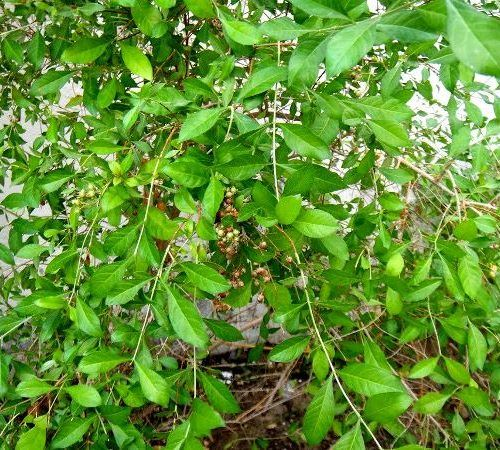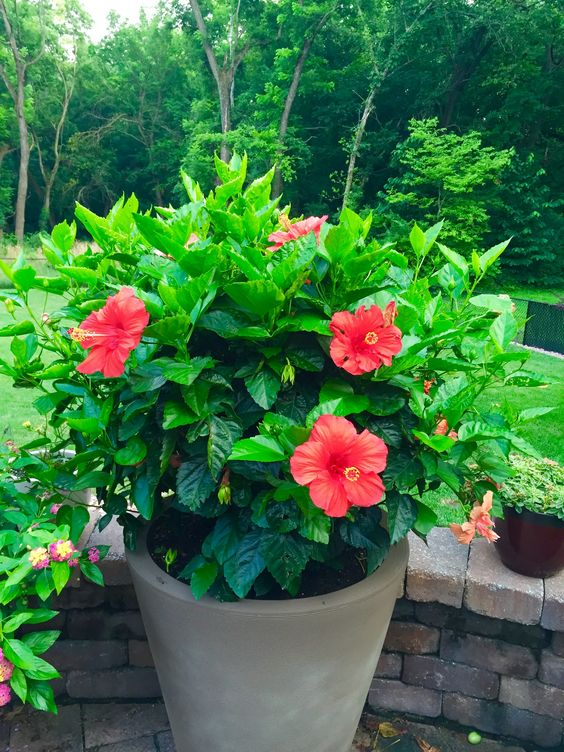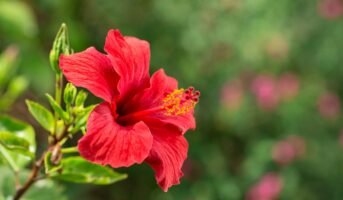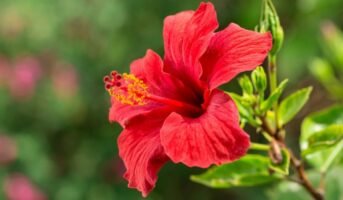The woody stems that remain above ground on shrubs are evidence that the plants themselves are perennial woody plants (compared with succulent stems of herbaceous plants). In general, shrubs can be differentiated from trees by their lower height and greater number of stems. Some shrubs, like hawthorn, lose their leaves in the winter, while others, like holly, keep theirs all year (e.g. holly). Theophrastus, a Greek philosopher from antiquity, classified plants into three categories: trees, shrubs, and herbs. dischidia is also belonged to shrubs plants type. Visit to know more. Salvia splendens is also known as a shrub plantin your garden. Learn more here.
Subshrubs are typically defined as low-growing shrubs that are typically less than 2 metres (6.6 feet) in height. Examples of subshrubs include lavender, periwinkle, and the majority of the smaller garden types of rose.
learn about: basil patta
What are shrub plants?
According to the majority of classifications, shrubs are characterised as having many stems but no primary trunk below. This is because the stems have branched out at a lower level, closer to the earth. Certain shrubs do have main trunks, although these are typically quite short and divide into several stems close to ground level without having a respectable length prior.
There are exceptions to this rule, however, since some shrubs do have main trunks. Oaks and ashes are two examples of trees that can develop into multi-stemmed forms while still reaching a height that qualifies them as trees. Examples of shrubs are croton, lemon, tulsi, rose, jasmine (chameli), bougainvillaea, china rose, pomegranate, henna (mehndi), etc.
See also: About Suaveolens
Shrub plants: Examples
Check out this list of some of the most popular shrubs for home gardens.
Henna
Mehndi is an all-natural plant used for both its dye and its medical characteristics. Its leaves, flowers, seeds, and bark all have healing properties. Applying mehndi to one’s hands is not just a lovely and auspicious tradition during weddings but also during many other significant holidays. A perennial shrub, the mehndi plant (Lawsonia inermis) is cultivated for its leaves for the industrial henna dye industry. Its sweetly scented blossoms have earned it the name Madyantika. Lasone, a chemical found in henna leaves, is used to provide colour to hair and skin.

Source: Pinterest
Pomegranate
Punica granatum is a shrub or small tree of the family Lythraceae. The fruit’s juiciest part, the arils, are enjoyed fresh, and the juice is turned into grenadine syrup, which is added to cocktails for flavour. Pomegranate is an excellent source of dietary fibre, folate, and vitamins C and K. The plant, which may grow as tall as 7 metres (23 feet), has brilliant green, elliptic to lance-shaped leaves that are roughly 7.5 centimetres (3 inches) long.
The attractive orange-red axillary flowers sit at the very tips of the branchlets. The calyx, which consists of the sepals, is tubular and persistent, and it has five to seven lobes. The petals, which are formed like lances, are inserted between the lobes of the calyx. Within the calyx tube, the ovary is divided into two sets of compartments that run vertically.

Source: Pinterest
China rose
In the wild, the tropical Chinese hibiscus, also known as the China rose (Hibiscus rosa-sinensis), can grow to a height of 4.5 metres (15 feet). However, when grown indoors, its height is more typically kept to a manageable 2 metres (6.5 feet).
Plants of this species are cultivated for their showy, big flowers. Flowers of different colours can be seen on cultivated kinds. The East African hibiscus (H. schizopetalus) is a trailing shrub with highly lobed crimson petals, and it is frequently cultivated in hanging baskets inside.

Source: Pinterest
See also: What is Hibiscus and how to grow it in your home?
Bougainvillea
Bougainvillaea, or the genus Bougainvillea, is a family of roughly 18 different species of South American shrubs, vines, and even a few tiny trees that are together known as the four-o’clock family (Nyctaginaceae). You’ll find thorns on many different kinds of plants. Woody vines have gotten a lot of attention on their own, and several species have given rise to beautiful ornamental cultivars that are popular for growing indoors and in greenhouses.
One species, B. glabra, native to Brazil, is known as paperflower because of the brilliantly coloured papery bracts that surround the tiny blooms. These bracts range in colour from purple and magenta to lighter shades. In warm areas, the stems of B. glabra can reach heights of 20 to 30 metres (approximately 60 to 100 feet), and the plant blooms for the majority of the year. B. spectabilis has a hairy stem, and its flowers don’t last long.

Source: Pinterest
See also: Everything a rookie gardener needs to know about Bougainvillea glabra
Croton
Croton (Codiaeum variegatum) is a widely cultivated, multicoloured-leaved shrub of the spurge family (Euphorbiaceae) that is native to Malaysia and the Pacific. The plant is widely cultivated as an ornamental, with numerous horticultural variants available as shrubs or small trees. Croton is toxic, and its sap is unpleasant to the skin, like many other members of the family.
Croton trees can grow up to 20 feet tall (6 m), but the types used as houseplants are typically much smaller. The leaves of these plants are evergreen and lustrous, and leathery. Many different shades of green, yellow, white, orange, pink, red, and purple can be seen in leaves because of anthocyanin. The leaves, which range in size from 5 to 15 centimetres (2 to 6 inches) long, can be linear or lance-shaped, oval, or lobed. Cuttings of the stems can be used to start new plants.

Source: Pinterest
See also: All about Bougainvillea Spectabilis
Tulsi
The flowering plant holy basil (Ocimum tenuiflorum), commonly known as tulsi or tulasi, is a member of the mint family (Lamiaceae) and is valued for its fragrant leaves. In addition to its homeland in India, Southeast Asia is also a key region for the cultivation of holy basil. Tulsi is widely used in Ayurvedic and folk medicine, frequently as a herbal tea for a range of diseases, and is regarded sacred in Hinduism. It is also used as a culinary condiment for its strong flavour that intensifies with cooking. It is suggestive of clove, Italian basil (Ocimum basilicum), and mint and has a peppery spice. In certain places outside of its natural habitat, it is viewed as an agricultural weed and an invasive species.

Source: Pinterest
Know about: Acalypha Wilkesiana
Lemon
A member of the rue family (Rutaceae), the lemon (Citrus limon) is a tiny tree or spreading shrub that bears delicious fruit. Tarts and the classic American dish, lemon meringue pie, both feature lemon juice as a defining element. Fresh or preserved, the fruit adds a unique astringent flavour to a broad variety of poultry, fish, and vegetable meals all around the world.
Lemonade, a refreshing drink made from lemon, sugar, and water, is often consumed during the warmer months, and lemon juice is often used as a flavouring in other beverages, such as tea. Lemon juice is high in vitamin C and has several B vitamins, including thiamin, riboflavin, and niacin, in lower amounts. The citric acid content may be as high as 5% by weight.

Source: Pinterest
Jasmine
About 200 species of fragrant-flowered shrubs and vines belong to the genus Jasminum, sometimes written as jessamine (Oleaceae). These plants thrive naturally in a few temperate and tropical places in the world. There are a few temperate and tropical places in the world where these plants thrive naturally. Many are grown specifically for their aesthetic value.
True jasmines typically feature climbing branches rather than tendrils. Some double-flowered variants have been created, and the flowers are tubular with a flaring, lobed, pinwheel-like appearance in shades of white, yellow, or very rarely pink. The leaves may remain green year-round or turn colours in the fall; most species have two or more leaflets, while a few have only one. The typical species’ fruit is a dark purple or blackberry with two distinct lobes.

Source: Pinterest
Shrub plants: How to choose the right shrub?
Here are some factors to consider while choosing the best shrub to grow in your home garden.
Mature size
Selecting a shrub that will outgrow its space will only result in additional maintenance in the future. Keep in mind that shrubs are rather permanent landscape features that can be difficult to relocate. Dwarf or compact cultivars are excellent options for the majority of home landscaping. However, the dwarf does not always imply diminutive size; it just denotes a smaller-than-average size for its species. Additionally, dwarf shrubs may cost a bit more (they tend to grow more slowly), but choosing the proper plant for the location will save you time and money over time.
Structure
Look for vegetation with a solid structure. A shrub with abundant branching and symmetrical growth is preferable to the tallest plant in the group.
Roots
It is acceptable to examine the roots by carefully removing the plant from its container. A large number of healthy white or light brown roots is a positive sign. A plant with healthy roots will stick to the earth, whereas one with root-bound roots will have roots circling the perimeter.
Flowers
Despite the fact that it is enticing to purchase a beautiful shrub that is covered with blooms, flower buds are sometimes the better option. Thus, you will be able to appreciate the flowers from bud to full bloom in your garden.
Overall health
Look for healthy green leaves unless the plant in concern has yellow leaves. There should be no obvious signs of pests or weeds, and the soil should be moist.
How to grow shrub plants?
Shrubs can be planted throughout the year. However, fall and spring are usually the best time for growing these plants. Follow these steps to plant a shrub in your garden:
- Dig a hole just as deep and twice as wide as the container’s size.
- Add a controlled-release fertiliser into the bottom of the planting hole.
- Gently remove the plant from the pot and use your fingers to loosen the roots.
- Place it in the hole and fill it with the native soil.
- Keep firming the soil as you fill it.
- Make sure that the tip of the root ball is covered by half an inch of soil once done.
- Cover it with a 2-3 inch layer of shredded bark mulch.
- Water the plant deeply during the growing phase.
Shrub plants: Care tips
Here are some tips to maintain shrubs in your backyard.
- Water deeply but not very frequently to help the scrub establish a strong root system.
- Water regularly all through the first year.
- Give the established shrub a slow-release fertiliser during the early spring to make the plant resistant to pests and diseases.
- Don’t prune your shrub much. Light pruning right after flowering is great to encourage more blooms.
- Prune evergreen shrubs in the spring after new growth has emerged.
Shrub plants: Benefits
There are plenty of benefits of growing shrubs in and around your home, These include:
- Shrubs serve as excellent windbreaks during the winters, keeping your house cosy during chilly seasons. They also provide cool shade during the hot summer months, helping you save on your electricity bills by reducing the need for AC.
- Many shrubs are widely popular for their ornamental beauty. While some have a vibrantly coloured foliage others grow beautiful flowers during the blooming season, making them an aesthetically pleasing addition to any garden.
- Shrubs have a great impact on the environment and are quite helpful in filtering pollutants and dust, improving the overall air quality of the surroundings. They also reduce erosion, decreasing stormwater runoff and toxic materials in waterways.
- Shrubs can be grown as privacy hedges to shield you and your home from the view of neighbours and anyone passing by. You can also grow shrubs to beautifully separate two different areas of your yard.
FAQs
What kind of plant is a shrub?
Any woody plant with many non-dominant stems and an average height of fewer than 3 metres (10 feet).
Does lavender belong to the shrub family?
Yes, lavender is a shrub.
Housing News Desk is the news desk of leading online real estate portal, Housing.com. Housing News Desk focuses on a variety of topics such as real estate laws, taxes, current news, property trends, home loans, rentals, décor, green homes, home improvement, etc. The main objective of the news desk, is to cover the real estate sector from the perspective of providing information that is useful to the end-user.
Facebook: https://www.facebook.com/housing.com/
Twitter: https://twitter.com/Housing
Email: [email protected]












